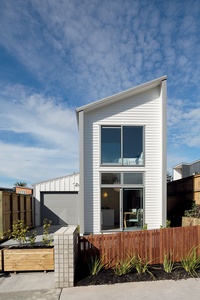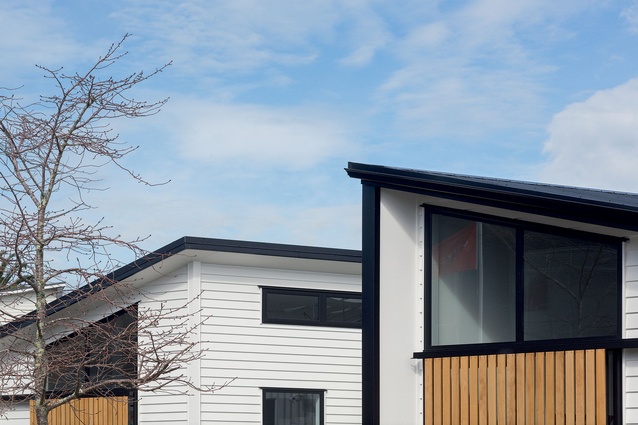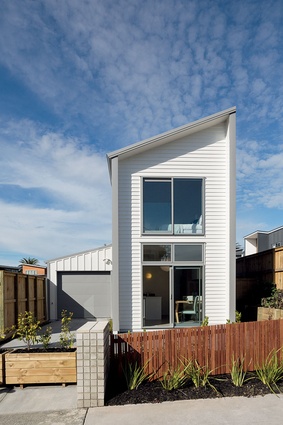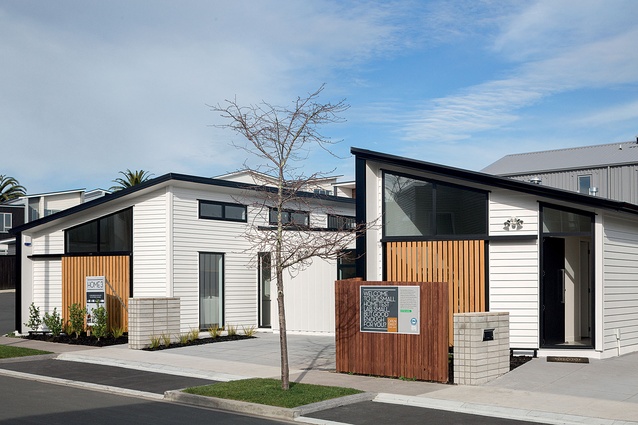Axis Series Small Home Test Lab
Hobsonville Point is a former air-force base in Auckland that is being developed with housing through a Crown-owned company that’s also a subsidiary of Housing New Zealand. One point that is often forgotten in the rhetoric about the housing shortage and housing affordability is that housing isn’t simply about putting roofs over people’s heads – it’s about creating communities.

The road to Hobsonville Point is an example of how things used to be done. On one side of a low ridge, we have endless tracts of subdivision-style developer housing: on the other, empty paddocks. Apart from the big-box retail up the road, there is little in the way of public amenities, parks or community facilities. Hobsonville Road was also a boundary: a Metropolitan Urban Limit where the North Western Motorway used to end. This was a well-intentioned device to limit urban sprawl but one that did little to ensure good-quality urban or suburban environments. Despite the current Government’s urging for more of the same cheap houses in cheap paddocks to solve the housing shortage, the people behind Hobsonville Point are doing things differently. There is a significant effort not just to squeeze in 3,000 houses but to build a community. The Point has a number of different precincts with different densities and types of housing; two schools are being built and, of course, there is a variety of parks, cafés, market places, community facilities and so on. The harbour-edge location contributes much to its character but so does the incorporation of a lot of the old housing stock and other buildings. It even has a new ferry service although, at this stage, if you blink you will miss it. Most inhabitants remain reliant on the extended motorway that now connects the area to both the North Shore and the Auckland isthmus.
What has really struck most Aucklanders about Hobsonville Point is the density of the housing. Even though it’s a massive site, there is a commitment to more compact housing than suburbanites are used to. The Small Home Test Lab is an experiment in small, detached homes on small sites, based on research developed by the Hobsonville Land Company, with three houses having been built from a range of eight developed by Isthmus in association with Architecture Workshop. All share a design concept of a raked, mono-pitch roof, the steel of which returns downwards to form a long rear wall un-perforated by windows. At each end, the roof can be extruded further to create more overhang or a porch-like area. Build costs range from $1,900 to $2,700 per m² plus GST.
House One at Hobsonville is a single-bedroomed 40m² dwelling on a 111m² section with one car-parking pad, selling for $340,000. That roof projection at the front and back could have been more generous as it seems like a conventional clipped eave over the front door and doesn’t provide any sheltered outdoor space at the rear. However, there is an argument that a basic home-ownership-entry-level house like this can provide the initial structure for further DIY additions such as a pergola or verandah. With a long narrow footprint, the plan is almost apartment like: bedroom, washing machine and bathroom to one side and a kitchen bench, dining table and couch at the end of the hall. What saves it from being too much like a granny’s flat is the raked ceiling that creates a sense of airiness and space rather than the usual flat lid with which we are familiar in economical housing.
House Two is a two-bedroomed, two-storeyed house with a similar long, narrow plan, 87m² on a 152m² site: yours for $450,000. Again, the conceptual extrusion of the plan by roof overhang, which could have created transitional outdoor spaces, is cropped back. This is probably a builder decision but it needs rethinking. Outdoor rooms work well in the Auckland climate, not just for living but for parking the bike and the BBQ, as well as drying clothes in winter – all things to be carefully considered when house designs are tight in floor area and storage. This plan works well with the kitchen/dining area at one end, separated by stairs and storage from the living area at the other. Stretching and separating key living areas like this, given proper site orientation, allows access to sun at each end of the day and gives a sense of a bigger house, rather than familiy members feeling that they are living on top of each other.
Two levels also allow a sense of escape upstairs and, once again, the two bedrooms are separated by the bathroom. After a wander around this well-designed but tight plan, however, it’s a bit of a surprise to discover a generous single garage attached to the house. Personally I have never felt the need to put a roof over my car, although I must confess to my happy place at home being the shed at the back of the garden. In Housing New Zealand projects targeted at Auckland’s Polynesian communities, it’s well known that garages are almost never used for automotive purposes. They are often occupied by the women in the weaving circle, elders around the kava bowl or young men hanging out. Similarly, garages can be places for hobbies, events, home occupations and so on. I’d stick a few windows in this to encourage its use as an overflow space for human occupation rather than just storage. In fact, it makes you wonder to what extent, as architects, we make our tasks harder as designers of small dwellings by hanging on to the stereotypical spaces devoted to dining/living/kitchen/bedroom and so on. Perhaps we could consider more adventurous alternative living arrangements? Difficult to gain approval from the developer, the real estate agent and the middle classes though; the architects proposed a studio-style dwelling but that wasn’t given the go-ahead for construction.
House Three is very much the most successful of the trio. One storey with three bedrooms, 89m2 on an 185m2 site: you can live there for $485,000 and I would. Clever placement of rooms and windows makes it seem bigger and, unlike the long narrow plans of the other two, this place stretches living and bedroom spaces to four quarters giving a good sense of complexity, spaciousness and separation. The direction of the roof pitch here allows a sloping ceiling rising upwards to long, high clerestory windows that provide not just a sense of space but fresh air and light while maintaining security.
One of the features that the architects uses to enhance this sense of space is floor-to-ceiling windows, including in the bedrooms. That’s fine in terms of individual houses – the rooms seem more generous and light filled – but the problem arises in a dense urban context of unfortunate sight lines and juxtapositions of houses that mean your bedroom and living areas can be much more visible to neighbours. It becomes clear that, whatever the characteristics of individual house types, what is crucial is great care in urban design to maintain decent views from windows (even if it is to a well-placed screen or shrub) and to avoid the neighbours having eyefuls of your private life. A solution by the architects that works well is the use of timber-slatted screens, which slide across the larger living and dining-area windows and work as sunshades also. These could usefully be employed on bedrooms as well since they maintain light but give a more pleasant sense of privacy than does swaddling windows with curtains.
A great advantage of this Small Home Test Lab is that 5,000 people have been through the houses and more than 1,000 have responded to surveys. The response has been positive with most saying they could see themselves living here. People were also keen on the environmental features that are often skipped in cheap house design. Each house is on a concrete slab, of course, for the thermal benefits, rainwater is collected and used in the laundry and to flush toilets, there’s a heat-pump hot-water system and so on; thus, the houses have Six Star Homestar ratings. Interestingly, section size was rated least important while good design was rated highly (who would have thought?) and simple things, such as the sloping ceilings, have been highly praised. Storage space remains important as are light and privacy, so House Three was most popular. In the end, however, if the house hit the right price point, then both house and section sizes were not issues.
So, in light of the Auckland Unitary Plan’s shift towards a more compact and denser city, the Hobsonville Point experiment and the Small Home Test Lab have been extremely useful with most respondents realising that good-quality design is more important than is size and there is a market for the small, well-designed house. The design team’s work here has assisted in not just convincing the public of that, but also the developers, builders and real estate agents. Let’s hope they don’t forget that clever design and quality are the keys though.












